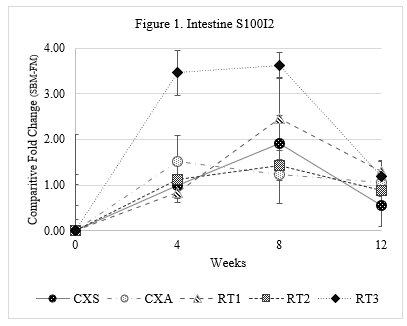COMPARATIVE ANALYSIS OF SOYBEAN MEAL EFFECTS IN COMMERCIAL STRAINS OF RAINBOW TROUT Oncorhynchus mykiss
A strain of rainbow trout (CX strain) at the Hagerman Fish Culture Experiment Station has been selected for growth on plant-based feeds for ten generations. We compared fish from the CX strain that were age (CXA) and size (CXS) matched to commonly available commercial strains selected for growth (RT1, RT2, RT3). We compared differences in oral tolerance, intestinal inflammation and overall growth between fish fed a fishmeal (FM) or soybean-meal (SBM) diet for 12 weeks . Fish (5.7 ± 0.2 g) of each strain were randomly assigned to FM or SBM diet groups and fed daily to satiation . Tissues from each experimental group were sampled every four weeks to assess gene expression, growth, histology and enzyme activity. The CX strain had higher growth rates compared with similar feed consumption among all groups. Transcription of i ntestinal and hepatic biomarkers for inflammation and stress peaked at 8 weeks among most strains fed the SBM diet and declined by 12 weeks as shown in Figure 1 with intestinal calcium-binding S100I2 expression. Enzymatic activity followed gene expression but remained elevated at 12 weeks. Semiquantitative histological examination indicated initial signs of enteritis in gut epithelial tissues.
